2014 NISSAN 370Z COUPE ECO mode
[x] Cancel search: ECO modePage 14 of 428
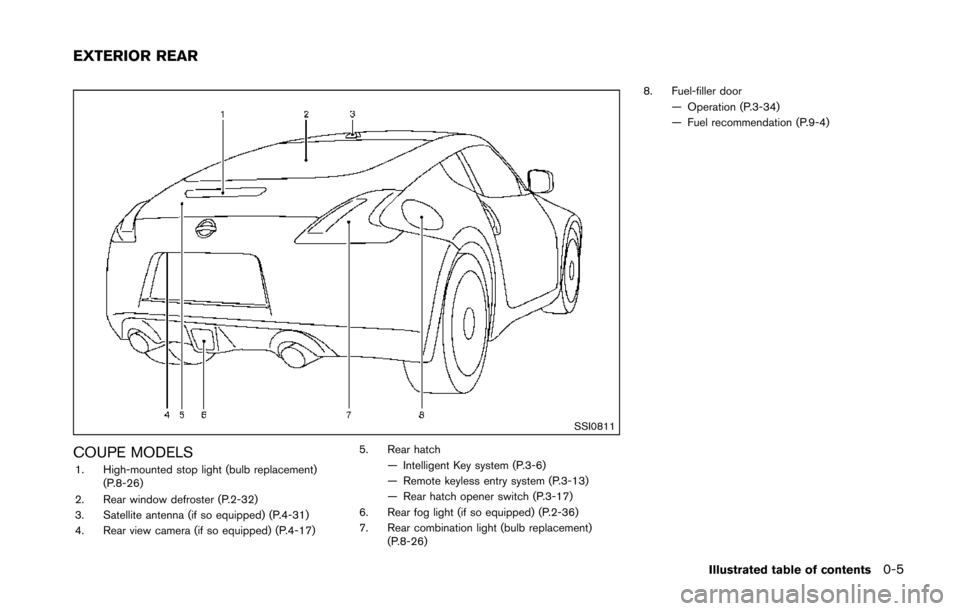
SSI0811
COUPE MODELS1. High-mounted stop light (bulb replacement)(P.8-26)
2. Rear window defroster (P.2-32)
3. Satellite antenna (if so equipped) (P.4-31)
4. Rear view camera (if so equipped) (P.4-17) 5. Rear hatch
— Intelligent Key system (P.3-6)
— Remote keyless entry system (P.3-13)
— Rear hatch opener switch (P.3-17)
6. Rear fog light (if so equipped) (P.2-36)
7. Rear combination light (bulb replacement) (P.8-26) 8. Fuel-filler door
— Operation (P.3-34)
— Fuel recommendation (P.9-4)
Illustrated table of contents0-5
EXTERIOR REAR
Page 15 of 428
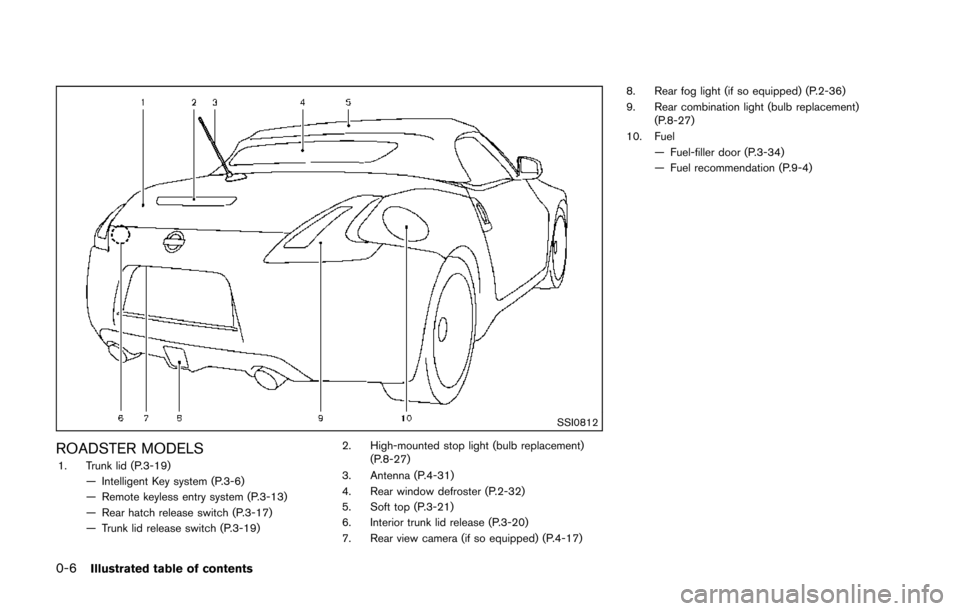
0-6Illustrated table of contents
SSI0812
ROADSTER MODELS1. Trunk lid (P.3-19)— Intelligent Key system (P.3-6)
— Remote keyless entry system (P.3-13)
— Rear hatch release switch (P.3-17)
— Trunk lid release switch (P.3-19) 2. High-mounted stop light (bulb replacement)
(P.8-27)
3. Antenna (P.4-31)
4. Rear window defroster (P.2-32)
5. Soft top (P.3-21)
6. Interior trunk lid release (P.3-20)
7. Rear view camera (if so equipped) (P.4-17) 8. Rear fog light (if so equipped) (P.2-36)
9. Rear combination light (bulb replacement)
(P.8-27)
10. Fuel — Fuel-filler door (P.3-34)
— Fuel recommendation (P.9-4)
Page 17 of 428
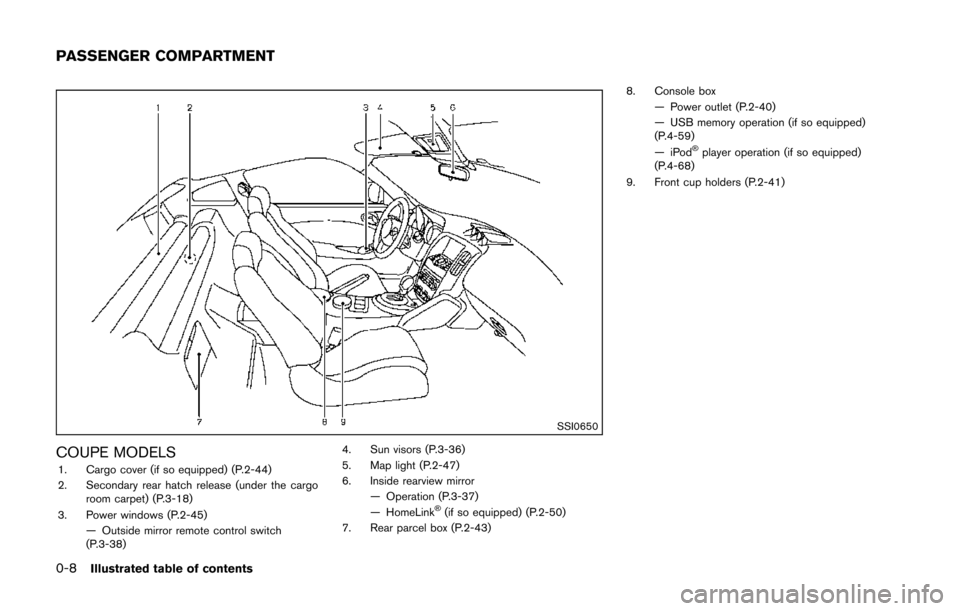
0-8Illustrated table of contents
SSI0650
COUPE MODELS1. Cargo cover (if so equipped) (P.2-44)
2. Secondary rear hatch release (under the cargoroom carpet) (P.3-18)
3. Power windows (P.2-45) — Outside mirror remote control switch
(P.3-38) 4. Sun visors (P.3-36)
5. Map light (P.2-47)
6. Inside rearview mirror
— Operation (P.3-37)
— HomeLink
®(if so equipped) (P.2-50)
7. Rear parcel box (P.2-43) 8. Console box
— Power outlet (P.2-40)
— USB memory operation (if so equipped)
(P.4-59)
—iPod
®player operation (if so equipped)
(P.4-68)
9. Front cup holders (P.2-41)
PASSENGER COMPARTMENT
Page 18 of 428
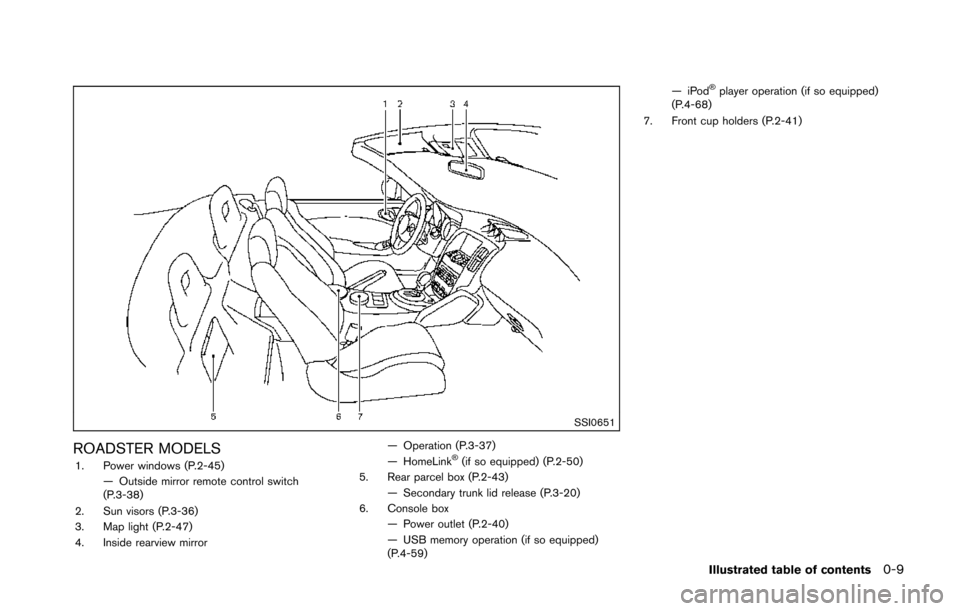
SSI0651
ROADSTER MODELS1. Power windows (P.2-45)— Outside mirror remote control switch
(P.3-38)
2. Sun visors (P.3-36)
3. Map light (P.2-47)
4. Inside rearview mirror — Operation (P.3-37)
— HomeLink®(if so equipped) (P.2-50)
5. Rear parcel box (P.2-43) — Secondary trunk lid release (P.3-20)
6. Console box
— Power outlet (P.2-40)
— USB memory operation (if so equipped)
(P.4-59) —iPod
®player operation (if so equipped)
(P.4-68)
7. Front cup holders (P.2-41)
Illustrated table of contents0-9
Page 34 of 428
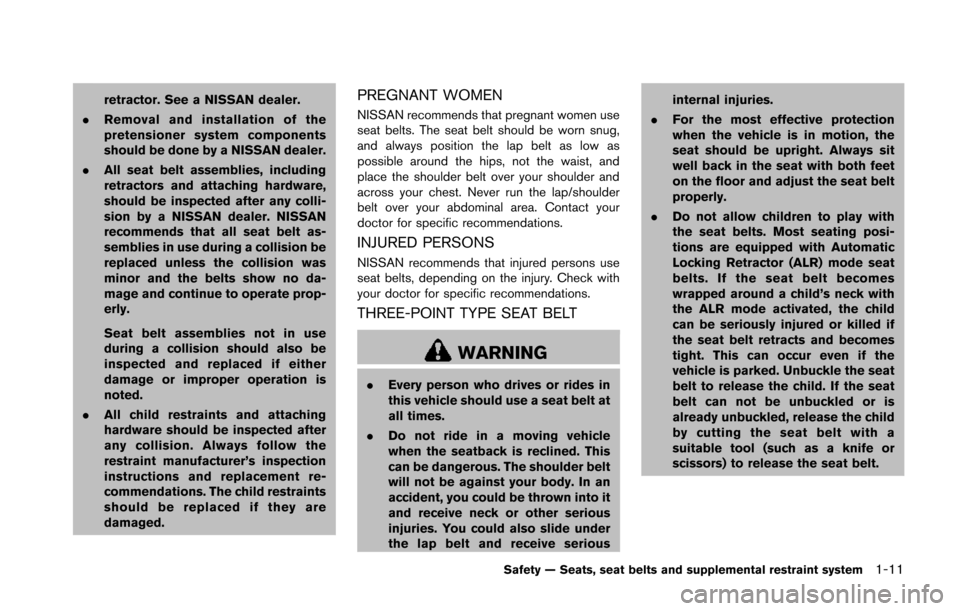
retractor. See a NISSAN dealer.
. Removal and installation of the
pretensioner system components
should be done by a NISSAN dealer.
. All seat belt assemblies, including
retractors and attaching hardware,
should be inspected after any colli-
sion by a NISSAN dealer. NISSAN
recommends that all seat belt as-
semblies in use during a collision be
replaced unless the collision was
minor and the belts show no da-
mage and continue to operate prop-
erly.
Seat belt assemblies not in use
during a collision should also be
inspected and replaced if either
damage or improper operation is
noted.
. All child restraints and attaching
hardware should be inspected after
any collision. Always follow the
restraint manufacturer’s inspection
instructions and replacement re-
commendations. The child restraints
should be replaced if they are
damaged.PREGNANT WOMEN
NISSAN recommends that pregnant women use
seat belts. The seat belt should be worn snug,
and always position the lap belt as low as
possible around the hips, not the waist, and
place the shoulder belt over your shoulder and
across your chest. Never run the lap/shoulder
belt over your abdominal area. Contact your
doctor for specific recommendations.
INJURED PERSONS
NISSAN recommends that injured persons use
seat belts, depending on the injury. Check with
your doctor for specific recommendations.
THREE-POINT TYPE SEAT BELT
WARNING
.Every person who drives or rides in
this vehicle should use a seat belt at
all times.
. Do not ride in a moving vehicle
when the seatback is reclined. This
can be dangerous. The shoulder belt
will not be against your body. In an
accident, you could be thrown into it
and receive neck or other serious
injuries. You could also slide under
the lap belt and receive serious internal injuries.
. For the most effective protection
when the vehicle is in motion, the
seat should be upright. Always sit
well back in the seat with both feet
on the floor and adjust the seat belt
properly.
. Do not allow children to play with
the seat belts. Most seating posi-
tions are equipped with Automatic
Locking Retractor (ALR) mode seat
belts. If the seat belt becomes
wrapped around a child’s neck with
the ALR mode activated, the child
can be seriously injured or killed if
the seat belt retracts and becomes
tight. This can occur even if the
vehicle is parked. Unbuckle the seat
belt to release the child. If the seat
belt can not be unbuckled or is
already unbuckled, release the child
by cutting the seat belt with a
suitable tool (such as a knife or
scissors) to release the seat belt.
Safety — Seats, seat belts and supplemental restraint system1-11
Page 37 of 428
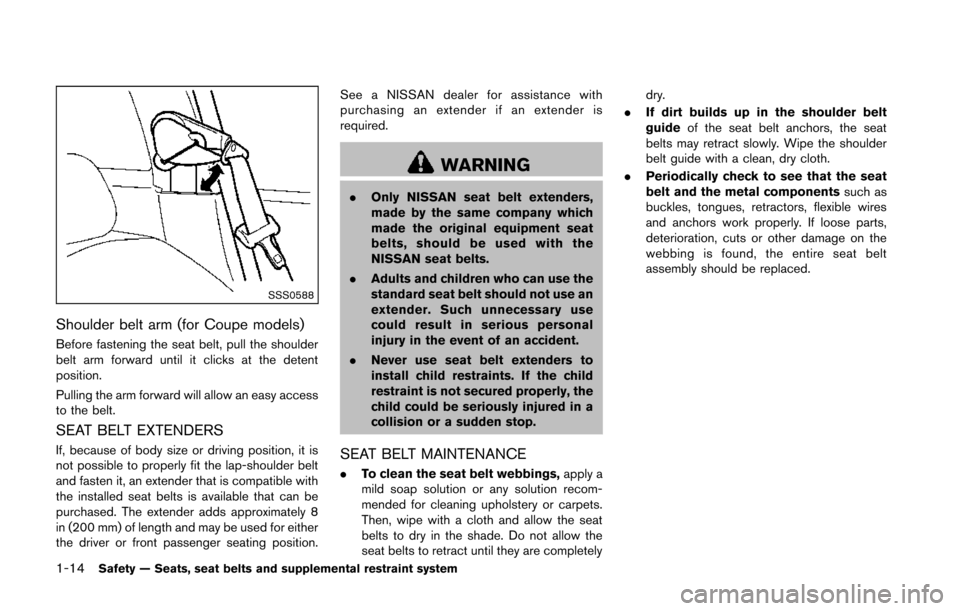
1-14Safety — Seats, seat belts and supplemental restraint system
SSS0588
Shoulder belt arm (for Coupe models)
Before fastening the seat belt, pull the shoulder
belt arm forward until it clicks at the detent
position.
Pulling the arm forward will allow an easy access
to the belt.
SEAT BELT EXTENDERS
If, because of body size or driving position, it is
not possible to properly fit the lap-shoulder belt
and fasten it, an extender that is compatible with
the installed seat belts is available that can be
purchased. The extender adds approximately 8
in (200 mm) of length and may be used for either
the driver or front passenger seating position.See a NISSAN dealer for assistance with
purchasing an extender if an extender is
required.
WARNING
.
Only NISSAN seat belt extenders,
made by the same company which
made the original equipment seat
belts, should be used with the
NISSAN seat belts.
. Adults and children who can use the
standard seat belt should not use an
extender. Such unnecessary use
could result in serious personal
injury in the event of an accident.
. Never use seat belt extenders to
install child restraints. If the child
restraint is not secured properly, the
child could be seriously injured in a
collision or a sudden stop.
SEAT BELT MAINTENANCE
.To clean the seat belt webbings, apply a
mild soap solution or any solution recom-
mended for cleaning upholstery or carpets.
Then, wipe with a cloth and allow the seat
belts to dry in the shade. Do not allow the
seat belts to retract until they are completely dry.
. If dirt builds up in the shoulder belt
guide of the seat belt anchors, the seat
belts may retract slowly. Wipe the shoulder
belt guide with a clean, dry cloth.
. Periodically check to see that the seat
belt and the metal components such as
buckles, tongues, retractors, flexible wires
and anchors work properly. If loose parts,
deterioration, cuts or other damage on the
webbing is found, the entire seat belt
assembly should be replaced.
Page 38 of 428
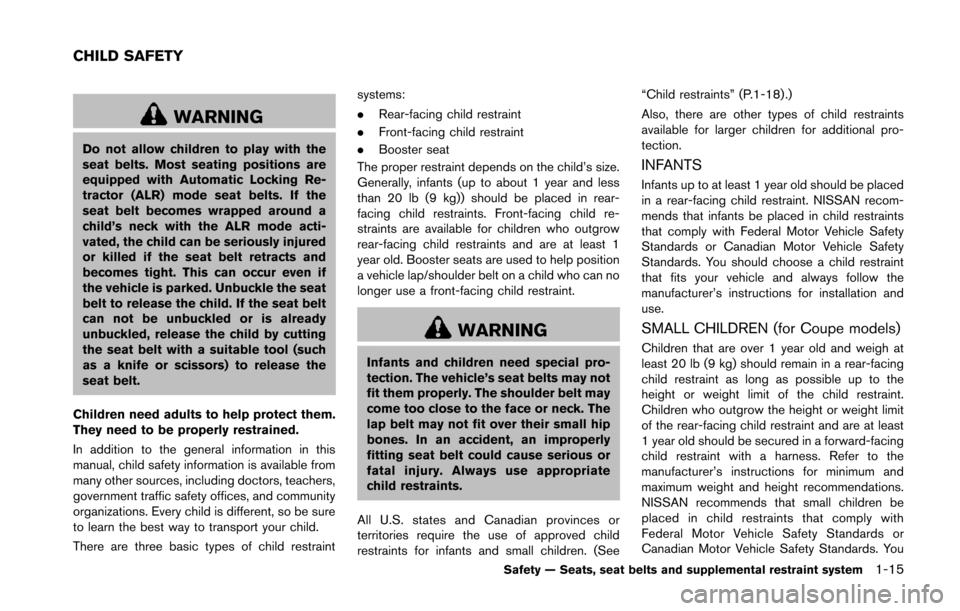
WARNING
Do not allow children to play with the
seat belts. Most seating positions are
equipped with Automatic Locking Re-
tractor (ALR) mode seat belts. If the
seat belt becomes wrapped around a
child’s neck with the ALR mode acti-
vated, the child can be seriously injured
or killed if the seat belt retracts and
becomes tight. This can occur even if
the vehicle is parked. Unbuckle the seat
belt to release the child. If the seat belt
can not be unbuckled or is already
unbuckled, release the child by cutting
the seat belt with a suitable tool (such
as a knife or scissors) to release the
seat belt.
Children need adults to help protect them.
They need to be properly restrained.
In addition to the general information in this
manual, child safety information is available from
many other sources, including doctors, teachers,
government traffic safety offices, and community
organizations. Every child is different, so be sure
to learn the best way to transport your child.
There are three basic types of child restraint systems:
.
Rear-facing child restraint
. Front-facing child restraint
. Booster seat
The proper restraint depends on the child’s size.
Generally, infants (up to about 1 year and less
than 20 lb (9 kg)) should be placed in rear-
facing child restraints. Front-facing child re-
straints are available for children who outgrow
rear-facing child restraints and are at least 1
year old. Booster seats are used to help position
a vehicle lap/shoulder belt on a child who can no
longer use a front-facing child restraint.
WARNING
Infants and children need special pro-
tection. The vehicle’s seat belts may not
fit them properly. The shoulder belt may
come too close to the face or neck. The
lap belt may not fit over their small hip
bones. In an accident, an improperly
fitting seat belt could cause serious or
fatal injury. Always use appropriate
child restraints.
All U.S. states and Canadian provinces or
territories require the use of approved child
restraints for infants and small children. (See “Child restraints” (P.1-18) .)
Also, there are other types of child restraints
available for larger children for additional pro-
tection.
INFANTS
Infants up to at least 1 year old should be placed
in a rear-facing child restraint. NISSAN recom-
mends that infants be placed in child restraints
that comply with Federal Motor Vehicle Safety
Standards or Canadian Motor Vehicle Safety
Standards. You should choose a child restraint
that fits your vehicle and always follow the
manufacturer’s instructions for installation and
use.
SMALL CHILDREN (for Coupe models)
Children that are over 1 year old and weigh at
least 20 lb (9 kg) should remain in a rear-facing
child restraint as long as possible up to the
height or weight limit of the child restraint.
Children who outgrow the height or weight limit
of the rear-facing child restraint and are at least
1 year old should be secured in a forward-facing
child restraint with a harness. Refer to the
manufacturer’s instructions for minimum and
maximum weight and height recommendations.
NISSAN recommends that small children be
placed in child restraints that comply with
Federal Motor Vehicle Safety Standards or
Canadian Motor Vehicle Safety Standards. You
Safety — Seats, seat belts and supplemental restraint system1-15
CHILD SAFETY
Page 41 of 428

1-18Safety — Seats, seat belts and supplemental restraint system
SSS0099
SSS0100
PRECAUTIONS ON CHILD RE-
STRAINTS
WARNING
.Failure to follow the warnings and
instructions for proper use and in-
stallation of child restraints could
result in serious injury or death of a
child or other passengers in a
sudden stop or collision:
— The child restraint must be used
and installed properly. Always
follow all of the child restraint
manufacturer’s instructions for
installation and use.
— Infants and children should never be held on anyone’s lap.
Even the strongest adult cannot
resist the forces of a collision.
— Do not put a seat belt around both a child and another pas-
senger.
— NISSAN recommends that all child restraints be installed in
the rear seat. Studies show that
children are safer when properly
restrained in the rear seat than in the front seat. If you must
install a forward-facing child
restraint in the front seat, see
“Forward-facing child restraint
installation using the seat belts
(for Coupe models)” (P.1-20) .
— Even with the NISSAN Advanced Air Bag System, never install a
rear-facing child restraint in the
front seat. An inflating air bag
could seriously injure or kill a
child.
— Be sure to purchase a child restraint that will fit the child
and vehicle. Some child re-
straints may not fit properly in
your vehicle.
— Child restraint anchor points are designed to withstand loads
from child restraints that are
properly fitted.
— Never use the anchor points for adult seat belts or harnesses.
— A child restraint with a top tether strap should not be used in the
front passenger seat (for Road-
ster models) .
CHILD RESTRAINTS